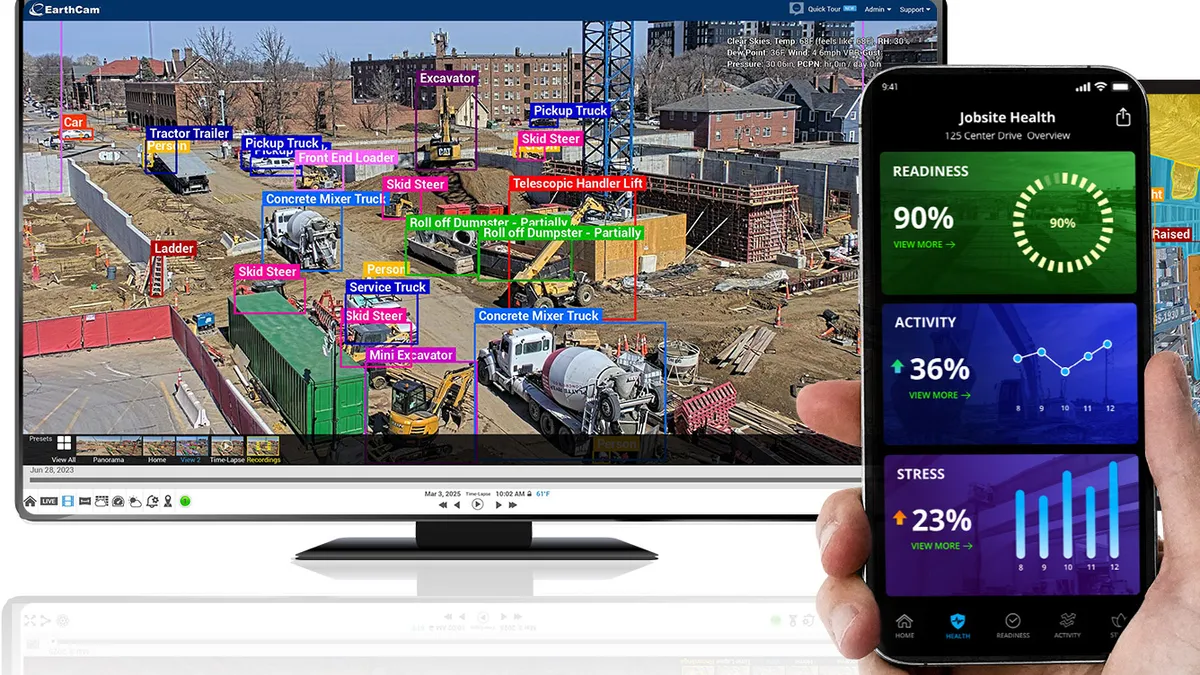Henning Roedel thinks questions about AI taking away jobs in construction miss the point.
“We don’t think about how to reduce our staff size, because we have enough backlog and work ahead of us that we need more people,” said Roedel, robotics lead for the innovation team at Redwood City, California-based DPR Construction. “You need to flip the displacement question around because we currently don’t have enough people in our industry to meet the construction needs of society as it is.”
The numbers back Roedel up. In March, even when construction layoffs reached their highest level since the start of the pandemic, there were still more than 341,000 unfilled jobs in the sector.
For Roedel, given the endemic labor crisis that’s been plaguing the industry for years, the early deployment of AI and robotic solutions into construction is evidence of job displacement and abandonment that has already occurred and threatened the industry’s ability to keep pace with demand.
“AI and robotics are solutions to that growing crisis of not being able to build enough homes, offices, and roads to keep people living healthy lives,” said Roedel, whose firm has been using both to help workers get more done. “The tools that are coming out are amplifying the lives of both our field and corporate office staffs, who can leverage ChatGPT and other tools to save mental time and productively move onto the next task that much earlier.”
Not drilling through rebar
For example, in addition to using ChatGPT for crafting email correspondence and project executive summaries based on bullet points and prompts, DPR is unleashing AI in the field.
This includes tools that incorporate computer vision, which derives meaningful information from images that crews can act on, an increased focus on jobsites. It also means AI-powered reality capture and analysis from the likes of the Hilti JAIBOT semi-automated drill.
When drilling into concrete slabs and ceilings for MEP inserts, the JAIBOT can detect obstructions, determine what they are and decide whether to continue drilling. AI can also measure the torque of the drill and determine if it hits rebar or any substrate other than concrete.
“With Hilti, we are seeing a productivity increase of 6X to 8X,” Roedel says. “It’s a huge improvement, and a lot of the performance gain has to do with the machine figuring out the right path and learning what not to hit.”
Productivity, not people
As AI garners increased attention globally, beyond robots and computer vision, it’s also gained a toehold within construction in areas like estimating and takeoffs via Togal.AI. But does broader adoption of AI tools threaten traditional job classes in construction? As new solutions are tested and deployed into the market, many seem naturally geared toward data-heavy and variable-laden job functions.
According to a World Economic Forum report, AI is predicted to replace 85 million human job functions globally within the next two years, with heavier losses in warehouse and manufacturing jobs, research and data entry, and customer service. In fact, construction laborers were at the bottom for workers whose jobs would see decreasing demand.
That jives with solution providers who say their technologies are designed to improve the productivity and well-being of human workers, not displace them, and speaks directly to Roedel’s point.
“AI is a very broad tool set,” Roedel said. “It can help with knowledge workers, it can help with robotics, it can help with a lot of different things.”
Making, rather than taking, jobs?
Just look at Dan Maxwell, vice president of development services for Knoxville, Tennessee-based construction advisory firm Realty Trust Group. He’s recently been leveraging generative AI such as Northspyre’s proactive intelligence platforms for real estate on projects, including the $46 million, 64,000 square foot Peeples Cancer Institute in Dalton, Georgia.
As an advisor first and foremost, Maxwell is interested in the productivity, efficiency, and cost impacts of AI to clients rather than any specific job displacements that might occur. He argues that generative AI and proactive intelligent tools can provide a localized job stimulus and position the construction industry as an adoption leader as the technologies evolve.
“We have to be flexible and stay in front of it and adapt and react thoughtfully,” he said. “But AI-enabled improvements to construction management and scheduling can push more projects and joint ventures forward for local job creation during and after construction.”
For example, the life science sector, heavy on complex MEP, vacuum tube pneumatics, and immuno-suprresant and life support systems, is seeing deployment of computer vision assisted and AI-enabled, autonomous robots for reality capture. It’s also witnessing a fast adoption of solutions that leverage AI to analyze how many people regularly access defined areas (and how often) to make best use of square footage.
“We have an opportunity in construction to not just be AI users, but to be facilitators of AI adoption in other sectors, too,” Maxwell said.
Will humans become a ‘protected class’?
Still, construction firms deploying AI tools need to be more aware of employment law liability, particularly if AI solutions disproportionately impact protected classes based on characteristics such as age, religion, race and sex.
“If AI or robotics results in the termination of someone’s job, there might be liability if it can be demonstrated that it constituted age discrimination versus just human discrimination,” said Andrew Richards, co-chair of Kaufman Dolowich & Voluck’s construction group, who’s based in Woodbury, New York. “Being a human being itself is not a protected class, but we’re watching science fiction become reality, and you can imagine that it could be an issue down the line.”
Richards said construction companies need to be more practically cognizant of AI’s fallibility, particularly as it relates to non-standardized, regional differences in the way the industry communicates and shares information. From payment processing to change orders to scheduling to building specifications, natural human differences in terminology could flummox AI analytics and cause disputes rather than solve them.
“There is a vast and deep complexity of terminology that contractors use that changes from jurisdiction to jurisdiction,” Richards said. “I’m not sure that we have a programming language yet that matches up with the real language of construction.”
Bringing tech to the masses
Despite those challenges, to the likes of Roedel and DPR, AI advancements and bolt-on solutions for robotics will lower the costs of reality capture and make the tech attainable for some of the firm’s smaller projects, too.
Indeed, the market size for AI in construction is forecast to grow 34.1% annually and eclipse the $8.5 billion mark by 2031, with the majority of system and solution deployment in improved operational costs and worker safety.
The latter is one area where DPR is fine with AI and robots displacing human job roles.
”We want to see more of these tools at work in high voltage scenarios and hazardous environments,” Roedel says. “Any hazmat applications where we can put the smart machines in and take the people away, so much the better.”



















